Initial Stage of the COVID-19 Pandemic: A Perspective on Health Risk Communications in the Restaurant Industry
Abstract
1. Introduction
2. Literature Review
2.1. Customer Review Websites as Health Risk Communication Channels
2.2. Quantitative Attributes on Customer Review Websites and Their Influences on Volume of Reviews
2.3. Qualitative Attributes on Customer Review Websites and Their Influences on Volume of Reviews
3. Methodology
3.1. Data Collection
3.2. Variables
3.3. Poisson Regression Model
4. Results and Discussions
4.1. Changes in Sentiment Polarity and Individual Emotions by Month
4.2. Regression Analysis
5. Conclusions
6. Limitations and Future Research
Author Contributions
Funding
Institutional Review Board Statement
Informed Consent Statement
Data Availability Statement
Conflicts of Interest
References
- Gursoy, D.; Chi, C.G. Effects of COVID-19 pandemic on hospitality industry: Review of the current situations and a research agenda. J. Hosp. Mark. Manag. 2020, 29, 527–529. [Google Scholar] [CrossRef]
- National Restaurant Association. Total Restaurant Industry Sales. 2020. Available online: https://restaurant.org/research/economy/indicators/restaurant-sales (accessed on 8 November 2020).
- Bucak, T.; Yiğit, S. The future of the chef occupation and the food and beverage sector after the COVID-19 outbreak: Opinions of Turkish chefs. Int. J. Hosp. Manag. 2020, 92, 102682. [Google Scholar] [CrossRef] [PubMed]
- Aaron Allen & Associates. How Coronavirus Is Impacting Restaurants. 2020. Available online: https://aaronallen.com/blog/restaurant-industry-coronavirus (accessed on 12 July 2021).
- Hakim, M.P.; Zanetta, L.D.; da Cunha, D.T. Should I stay, or should I go? Consumers' perceived risk and intention to visit restaurants during the COVID-19 pandemic in Brazil. Food Res. Int. 2021, 141, 110152. [Google Scholar] [CrossRef] [PubMed]
- Bae, S.Y.; Chang, P.-J. The effect of coronavirus disease-19 (COVID-19) risk perception on behavioural intention towards ‘untact’ tourism in South Korea during the first wave of the pandemic (March 2020). Curr. Issues Tour. 2020, 24, 1017–1035. [Google Scholar] [CrossRef]
- Ali, S.; Khalid, N.; Javed, H.; Islam, D. Consumer Adoption of Online Food Delivery Ordering (OFDO) Services in Pakistan: The Impact of the COVID-19 Pandemic Situation. J. Open Innov. Technol. Mark. Complex. 2020, 7, 10. [Google Scholar] [CrossRef]
- Wilson, T.D. Models in information behavior research. J. Doc. 1999, 55, 249–270. [Google Scholar] [CrossRef]
- Case, D.O.; Andrews, J.E.; Johnson, J.D.; Allard, S.L. Avoiding versus seeking: The relationship of information seeking to avoidance, blunting, coping, dissonance, and related concepts. J. Med Libr. Assoc. 2005, 93, 353–362. [Google Scholar]
- Rothman, A.J.; Kiviniemi, M.T. Treating people with information: An analysis and review of approaches to communicating health risk information. J. Natl. Cancer Inst. Monogr. 1999, 25, 44–51. [Google Scholar] [CrossRef] [PubMed]
- Barford, K.A.; Koval, P.; Kuppens, P.; Smillie, L.D. When Good Feelings Turn Mixed: Affective Dynamics and Big Five Trait Predictors of Mixed Emotions in Daily Life. Eur. J. Pers. 2020, 34, 393–411. [Google Scholar] [CrossRef]
- Smillie, L. Mixed Emotions during COVID-19. Osfhome. 2020. Available online: https://osf.io/72md9/?view_only=7dc3e33d77da4f2aa9add2a4713121af (accessed on 10 November 2020).
- Plutchik, R. The nature of emotions: Human emotions have deep evolutionary roots, a fact that may explain their complexity and provide tools for clinical practice. Am. Sci. 2001, 89, 344–350. [Google Scholar] [CrossRef]
- Foster, A.D.; Rosenzweig, M.R. Learning by Doing and Learning from Others: Human Capital and Technical Change in Agriculture. J. Politi.-Econ. 1995, 103, 1176–1209. [Google Scholar] [CrossRef]
- Ghose, A.; Ipeirotis, P.G. Estimating the helpfulness and economic impact of product reviews: Mining text and reviewer characteristics. IEEE Trans. Knowl. Data Eng. 2010, 23, 1498–1512. [Google Scholar] [CrossRef]
- Miniard, P.W.; Cohen, J.B. Modeling Personal and Normative Influences on Behavior. J. Consum. Res. 1983, 10, 169–180. [Google Scholar] [CrossRef]
- Petty, R.E.; Cacioppo, J.T. The effects of involvement on responses to argument quantity and quality: Central and peripheral routes to persuasion. J. Personal. Soc. Psychol. 1984, 46, 69. [Google Scholar] [CrossRef]
- Paulik, L.B.; Keenan, R.E.; Durda, J.L. The case for effective risk communication: Lessons from a global pandemic. Integr. Environ. Assess. Manag. 2020, 16, 552–554. [Google Scholar] [CrossRef]
- Sun, X.; Yang, W.; Sun, T.; Wang, Y.P. Negative Emotion under Haze: An Investigation Based on the Microblog and Weather Records of Tianjin, China. Int. J. Environ. Res. Public Health 2018, 16, 86. [Google Scholar] [CrossRef] [PubMed]
- Yang, Y.; Liu, K.; Li, S.; Shu, M. Social media activities, emotion regulation strategies, and their interactions on people’s mental health in COVID-19 pandemic. Int. J. Environ. Res. Public Health 2020, 17, 8931. [Google Scholar] [CrossRef]
- Niederdeppe, J.; Hornik, R.; Kelly, B.J.; Frosch, D.L.; Romantan, A.; Stevens, R.S.; Barg, F.; Weiner, J.L.; Schwartz, J.S. Examining the Dimensions of Cancer-Related Information Seeking and Scanning Behavior. Health Commun. 2007, 22, 153–167. [Google Scholar] [CrossRef] [PubMed]
- Rosen, N.O.; Knäuper, B. A Little Uncertainty Goes a Long Way: State and Trait Differences in Uncertainty Interact to Increase Information Seeking but Also Increase Worry. Health Commun. 2009, 24, 228–238. [Google Scholar] [CrossRef] [PubMed]
- Visschers, V.; Meertens, R.M.; Passchier, W.W.F.; De Vries, N.N.K. Probability Information in Risk Communication: A Review of the Research Literature. Risk Anal. 2009, 29, 267–287. [Google Scholar] [CrossRef] [PubMed]
- PAHO. Case Definitions for COVID-19 Surveillance. 2020. Available online: https://www.paho.org/en/topics/coronavirus-infections/coronavirus-disease-covid-19-pandemic/case-definitions-covid-19 (accessed on 20 July 2021).
- Lau, H.; Khosrawipour, T.; Kocbach, P.; Ichii, H.; Bania, J.; Khosrawipour, V. Evaluating the massive underreporting and undertesting of COVID-19 cases in multiple global epicenters. Pulmonology 2021, 27, 110–115. [Google Scholar] [CrossRef]
- Grabill, J.T.; Simmons, W.M. Toward a critical rhetoric of risk communication: Producing citizens and the role of technical communicators. Tech. Commun. Q. 1998, 7, 415–441. [Google Scholar] [CrossRef]
- Burleson, B.R.; Goldsmith, D.J. How the comforting process works: Alleviating emotional distress through conversationally induced reappraisals. In Handbook of Communication and Emotion: Research, Theory, Applications, and Contexts; Andersen, P.A., Guerrero, L.K., Eds.; Academic Press: Cambridge, MA, USA, 1998; pp. 245–280. [Google Scholar]
- Luo, Y.; Tang, L.; Kim, E.; Wang, X. Finding the reviews on yelp that actually matter to me: Innovative approach of improving recommender systems. Int. J. Hosp. Manag. 2020, 91, 102697. [Google Scholar] [CrossRef]
- Muller, C. Restaurant Delivery: Are “ODP” the Industrys “OTA”? Part I. Boston Hosp. Rev. 2018, 6, 1–17. [Google Scholar]
- Mehrolia, S.; Alagarsamy, S.; Solaikutty, V.M. Customers response to online food delivery services during COVID-19 outbreak using binary logistic regression. Int. J. Consum. Stud. 2020, 45, 396–408. [Google Scholar] [CrossRef] [PubMed]
- Khamidovich, Z.K. Pandemic and trends in the restaurant business in 2021. Cent. Asian J. Innov. Tour. Manag. Financ. 2021, 2, 54–61. [Google Scholar]
- Kostromitina, M.; Keller, D.; Cavusoglu, M.; Beloin, K. “His lack of a mask ruined everything.” Restaurant customer satisfaction during the COVID-19 outbreak: An analysis of Yelp review texts and star-ratings. Int. J. Hosp. Manag. 2021, 98, 103048. [Google Scholar] [CrossRef] [PubMed]
- de Souza, T.S.P.; Miyahira, R.F.; Matheus, J.R.V.; Nogueira, T.B.D.B.; Maragoni-Santos, C.; Barros, F.F.C.; Antunes, A.E.C.; Fai, A.E.C. Food services in times of uncertainty: Remodeling operations, changing trends, and looking into perspectives after the COVID-19 pandemic. Trends Food Sci. Technol. 2022, 120, 301–307. [Google Scholar] [CrossRef]
- Kim, J.; Wang, Y. Uncertainty risks and strategic reaction of restaurant firms amid COVID-19: Evidence from China. Int. J. Hosp. Manag. 2020, 92, 102752. [Google Scholar] [CrossRef]
- Alvarez-Palau, E.J.; Calvet-Liñán, L.; Viu-Roig, M.; Gandouz, M.; Juan, A.A. Economic profitability of last-mile food delivery services: Lessons from Barcelona. Res. Transp. Bus. Manag. 2021, 100659. [Google Scholar] [CrossRef]
- Kimes, S.; Chen, C. Consumer Perceptions of Restaurant Delivery Fees. Cornell Hosp. Rep. 2021, 21, 1–16. [Google Scholar]
- Yeo, V.C.S.; Goh, S.K.; Rezaei, S. Consumer experiences, attitude and behavioral intention toward online food delivery (OFD) services. J. Retail. Consum. Serv. 2017, 35, 150–162. [Google Scholar] [CrossRef]
- Reu, M. This Is What Customers Value the Most in Online Food Delivery. Deliverect. 2020. Available online: https://www.deliverect.com/blog/food-delivery/this-is-what-customers-value-the-most-in-online-food-delivery (accessed on 8 November 2020).
- Khan, S.; Hussain, S.M.; Yaqoob, F. Determinants of Customer Satisfaction in Fast Food Industry A Study of Fast Food Restaurants Peshawar Pakistan. Stud. Commer. Bratisl. 2013, 6, 56–65. [Google Scholar] [CrossRef]
- Lahap, J.; Azlan, R.I.; Bahri, K.A.; Said, N.M.; Abdullah, D.; Zain, R.A. The effect of perceived waiting time on customer’s satisfaction: A focus on fast food restaurant. Int. J. Supply Chain. Manag. 2018, 7, 259–266. [Google Scholar]
- Whitten, S. As Competition in the Food Delivery World Heats up, Restaurants Turn to Third Parties to Keep up. CNBC. 2018. Available online: https://www.cnbc.com/2018/03/16/food-delivery-competition-heats-up-third-parties-help-restaurants-keepup.html (accessed on 8 November 2020).
- Korsmeyer, C. Making Sense of Taste: Food and Philosophy; Cornell University Press: Ithaca, NY, USA, 1999. [Google Scholar]
- Belarmino, A.; Raab, C.; Tang, J.; Han, W. Exploring the motivations to use online meal delivery platforms: Before and during quarantine. Int. J. Hosp. Manag. 2021, 96, 102983. [Google Scholar] [CrossRef]
- SHARP. COVID-19 Numbers: What They Mean, Why They Matter. 2020. Available online: https://www.sharp.com/health-news/covid-19-numbers-what-they-mean-why-they-matter.cfm (accessed on 20 November 2020).
- Hang, H.; Aroean, L.; Chen, Z. Building emotional attachment during COVID-19. Ann. Tour. Res. 2020, 83, 103006. [Google Scholar] [CrossRef]
- Wang, X.; Tang, L.R.; Kim, E. More than words: Do emotional content and linguistic style matching matter on restaurant review helpfulness? Int. J. Hosp. Manag. 2019, 77, 438–447. [Google Scholar] [CrossRef]
- Francisco, V.; Gervás, P. Exploring the Compositionality of Emotions in Text: Word Emotions, Sentence Emotions and Automated Tagging. In AAAI-06 Workshop on Computational Aesthetics: Artificial Intelligence Approaches to Beauty and Happiness. 2006. Available online: https://www.aaai.org/Papers/Workshops/2006/WS-06-04/WS06-04-015.pdf (accessed on 15 December 2020).
- AlSheikh, S.S.; Shaalan, K.; Meziane, F. Consumers’ trust and popularity of negative posts in social media: A case study on the integration between B2C and C2C business models. In Proceedings of the 2017 International Conference on Behavioral, Economic, Socio-Cultural Computing (BESC), Krakow, Poland, 16–18 October 2017; pp. 1–6. [Google Scholar]
- Vojković, J. Film Costume as a Visual Narrative Element; Defining the Abstract Emotions of the Film Viewer via Plutchik’s Wheel of Emotions. Text. Leather Rev. 2020, 3, 92–100. [Google Scholar] [CrossRef]
- Oh, M.; Kim, S. Role of Emotions in Fine Dining Restaurant Online Reviews: The Applications of Semantic Network Analysis and a Machine Learning Algorithm. Int. J. Hosp. Tour. Adm. 2021, 23, 875–903. [Google Scholar] [CrossRef]
- Ekman, P. An argument for basic emotions. Cogn. Emot. 1992, 6, 169–200. [Google Scholar] [CrossRef]
- Felbermayr, A.; Nanopoulos, A. The Role of Emotions for the Perceived Usefulness in Online Customer Reviews. J. Interact. Mark. 2016, 36, 60–76. [Google Scholar] [CrossRef]
- Kim, S.; Bak, J.; Oh, A. Do you feel what I feel? social aspects of emotions in twitter conversations. In Proceedings of the International AAAI Conference on Web and Social Media (ICWSM), Dublin, Ireland, 4–8 June 2012; AAAI Publications: Palo Alto, CA, USA, 2012. [Google Scholar]
- Tromp, E.; Pechenizkiy, M. Rule-based emotion detection on social media: Putting tweets on Plutchik’s wheel. arXiv 2014, arXiv:1412.4682. [Google Scholar]
- Metzler, H.; Pellert, M.; Garcia, D. Using Social Media Data to Capture Emotions before and during COVID-19. World Happiness Report. 2022. Available online: https://worldhappiness.report/ed/2022/using-social-media-data-to-capture-emotions-before-and-during-covid-19 (accessed on 28 June 2021).
- CNN. 2020 Census Data: The United States Is More Diverse and More Multiracial than Ever—CNN Politics. CNN. 2021. Available online: https://edition.cnn.com/2021/08/12/politics/us-census-2020-data/index.html (accessed on 3 September 2021).
- Centers for Disease Control (CDC). Previous U.S. COVID-19 Case Data. 2020. Available online: https://www.cdc.gov/coronavirus/2019-ncov/covid-data/previouscases.html (accessed on 3 September 2021).
- Schuchat, A.; CDC COVID-19 Response Team. Public health response to the initiation and spread of pandemic COVID-19 in the United States, February 24–April 21, 2020. Morb. Mortal. Wkly. Rep. 2020, 69, 551–556. [Google Scholar] [CrossRef] [PubMed]
- Pennebaker, J. The secret life of pronouns. New Sci. 2011, 211, 42–45. [Google Scholar] [CrossRef]
- Pennebaker, J.W.; Boyd, R.L.; Jordan, K.; Blackburn, K. The Development and Psychometric Properties of LIWC2015; University of Texas at Austin: Austin, TX, USA, 2015. [Google Scholar]
- Mohammad, S.; Turney, P.D. Crowdsourcing a word-emotion association lexicon. Comput. Intell. 2012, 29, 436–465. [Google Scholar] [CrossRef]
- Loukachevitch, N. Automatic Sentiment Analysis of Texts: The Case of Russian. In The Palgrave Handbook of Digital Russia Studies; Palgrave Macmillan: London, UK, 2021; pp. 501–516. [Google Scholar]
- Weismayer, C.; Gunter, U.; Önder, I. Temporal variability of emotions in social media posts. Technol. Forecast. Soc. Chang. 2021, 167, 120699. [Google Scholar] [CrossRef]
- Aldous, K.K.; An, J.; Jansen, B.J. Measuring 9 Emotions of News Posts from 8 News Organizations across 4 Social Media Platforms for 8 Months. ACM Trans. Soc. Comput. (TSC) 2022, 4, 1–31. [Google Scholar] [CrossRef]
- Javed, N.; Muralidhara, B.L. Emotions During COVID-19: LSTM Models for Emotion Detection in Tweets. In Proceedings of the 2nd International Conference on Recent Trends in Machine Learning, IoT, Smart Cities and Applications, Hyderabad, India, 28–29 March 2022; Springer: Singapore, 2022; pp. 133–148. [Google Scholar]
- Aribowo, A.S.; Khomsah, S. Implementation of Text Mining For Emotion Detection Using The Lexicon Method (Case Study: Tweets About COVID-19). Telematika 2021, 18, 49–60. [Google Scholar] [CrossRef]
- Mathur, A.; Kubde, P.; Vaidya, S. Emotional analysis using twitter data during pandemic situation: COVID-19. In Proceedings of the 2020 5th International Conference on Communication and Electronics Systems (ICCES), Coimbatore, India, 10–12 June 2020; pp. 845–848. [Google Scholar]
- Berk, R.; MacDonald, J.M. Overdispersion and Poisson Regression. J. Quant. Criminol. 2008, 24, 269–284. [Google Scholar] [CrossRef]
- Consul, P.; Famoye, F. Generalized Poisson regression model. Commun. Stat.-Theory Methods 1992, 21, 89–109. [Google Scholar] [CrossRef]
- Frey, W.H. One Year in, COVID-19’s Uneven Spread across the US Continues. 2022. Available online: https://www.brookings.edu/research/one-year-in-covid-19s-uneven-spread-across-the-us-continues/ (accessed on 22 September 2021).
- WebMD. As Society Reopens, Not Everyone Is Ready. 2020. Available online: https://www.webmd.com/lung/news/20200505/as-society-reopens-not-everyone-is-ready (accessed on 22 September 2021).
- Reisenzein, R. Exploring the strength of association between the components of emotion syndromes: The case of surprise. Cogn. Emot. 2000, 14, 1–38. [Google Scholar] [CrossRef]
- Keltner, D.; Haidt, J. Social Functions of Emotions at Four Levels of Analysis. Cogn. Emot. 1999, 13, 505–521. [Google Scholar] [CrossRef]
- Arnold, M.B. Emotion and Personality; Columbia University Press: New York, NY, USA, 1960. [Google Scholar]
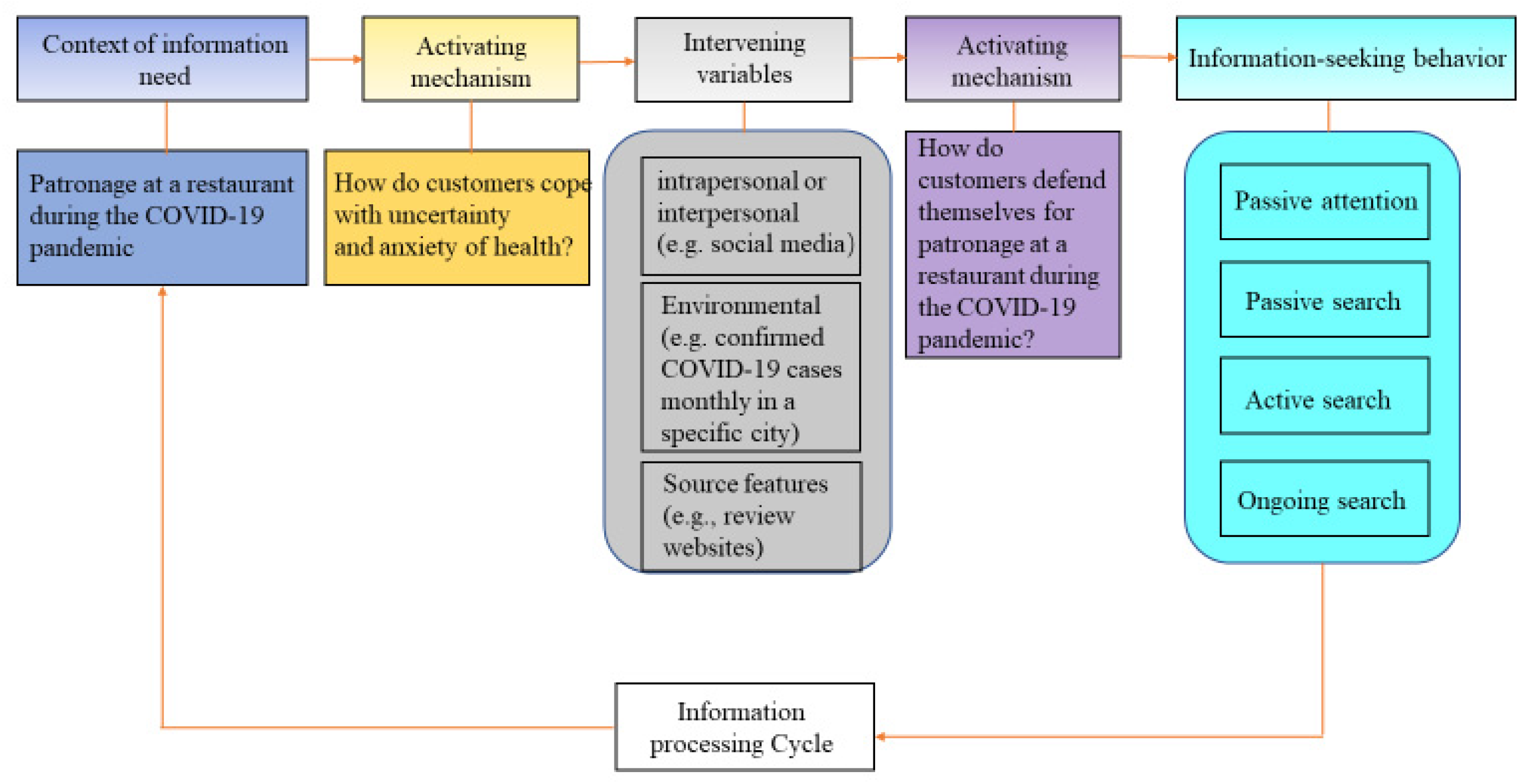
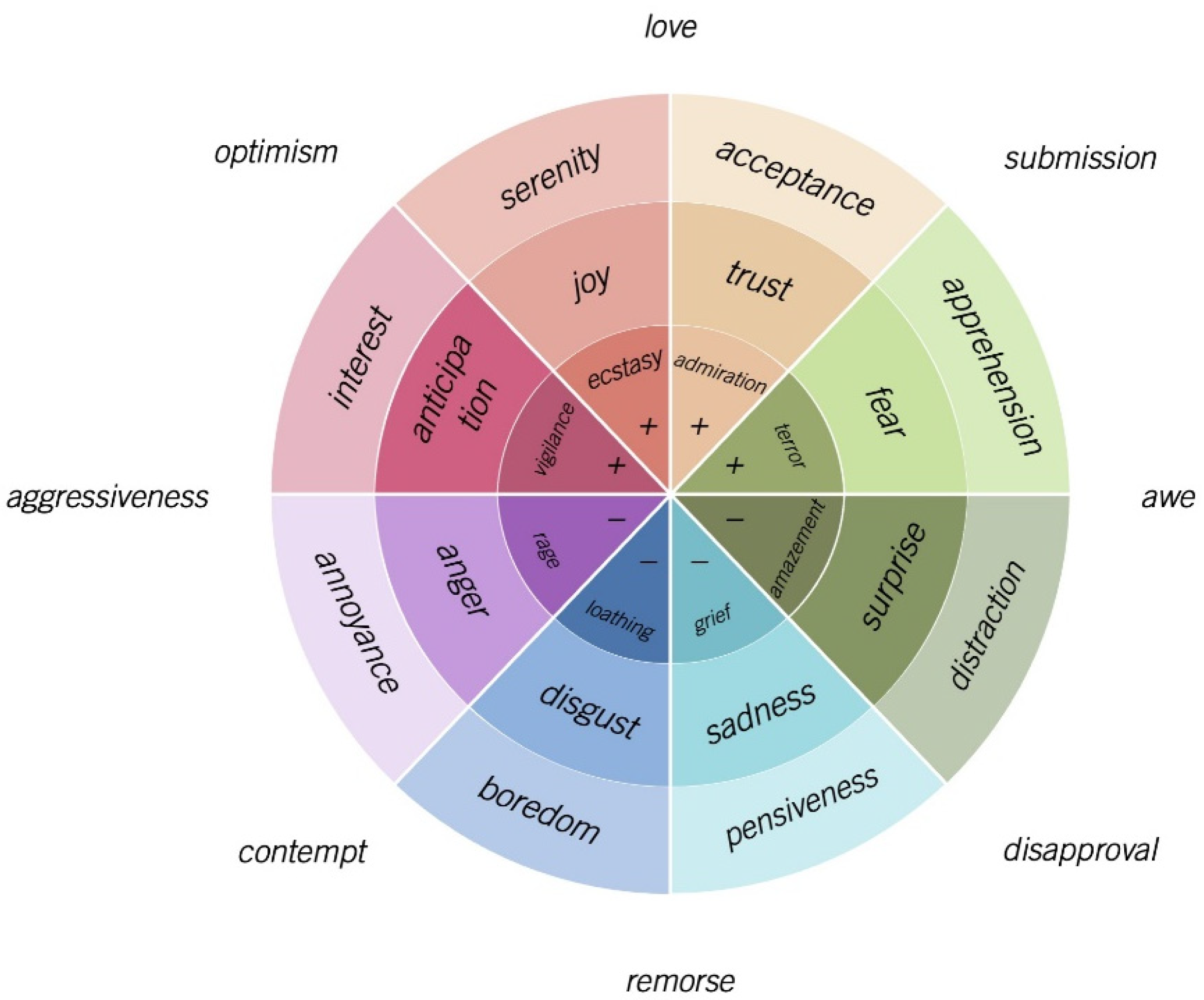

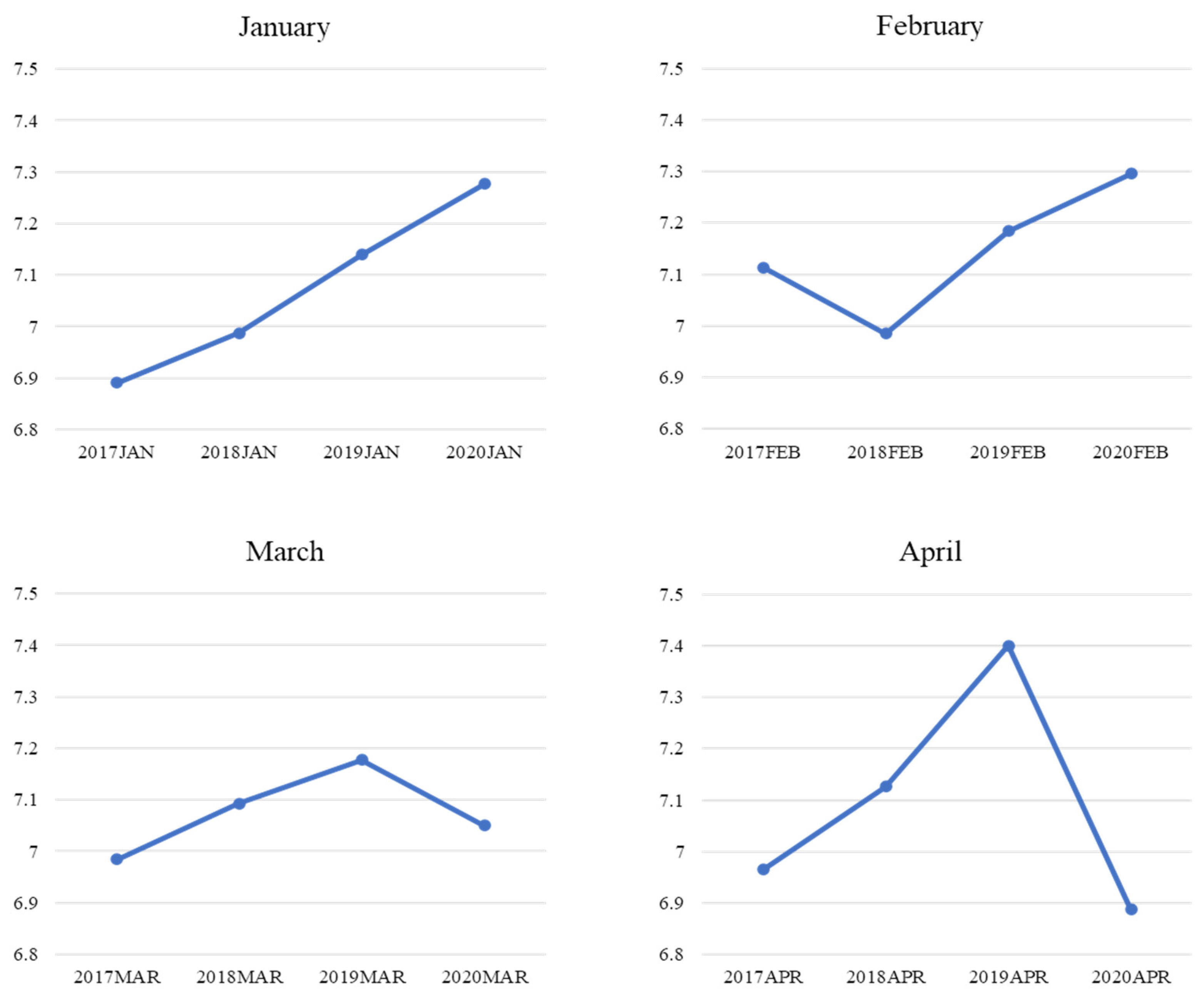
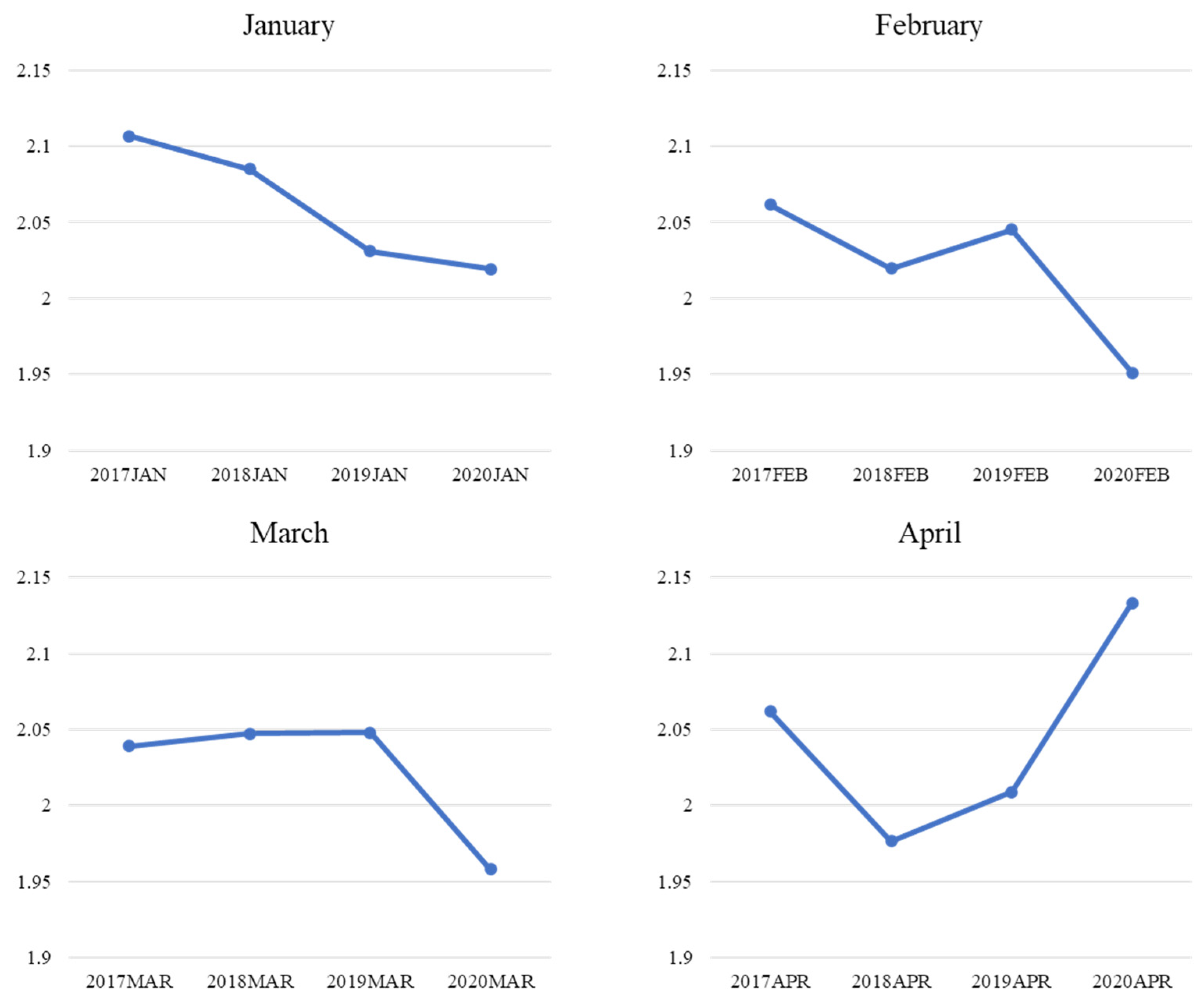
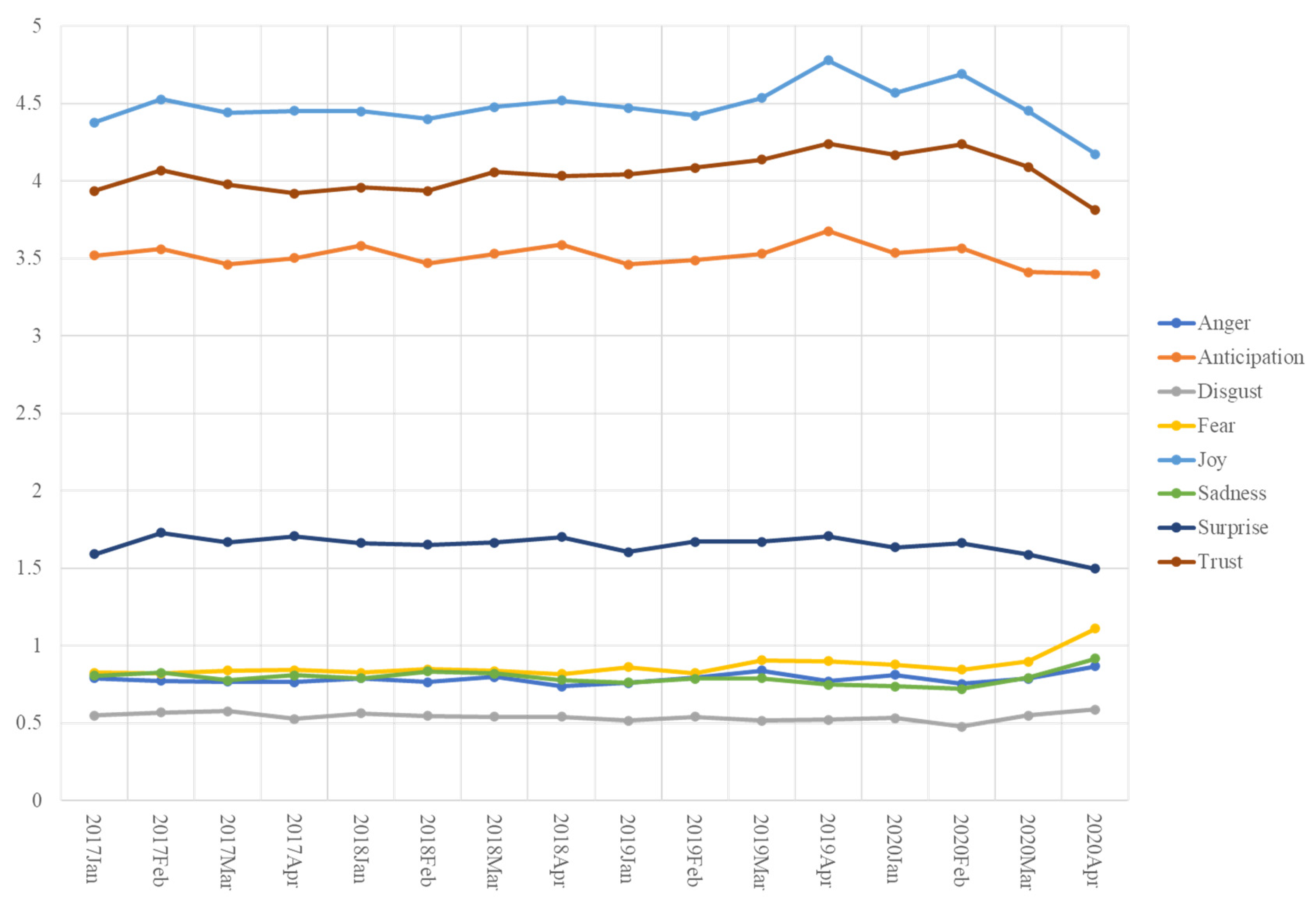
| t-Stat | df | Sig. 1-Tailed | Sig. 2-Tailed | Mean Difference | |
|---|---|---|---|---|---|
| January | |||||
| Positive | 4.06 | 19408 | 0.00 ** | 0.00 ** | 0.26 |
| Negative | −1.69 | 19408 | 0.05 * | 0.09 * | −0.05 |
| February | |||||
| Positive | 2.88 | 17587 | 0.00 ** | 0.00 ** | 0.20 |
| Negative | −2.80 | 17587 | 0.00 ** | 0.01 ** | −0.09 |
| March | |||||
| Positive | −0.51 | 17298 | 0.30 | 0.61 | −0.04 |
| Negative | −2.17 | 17298 | 0.01 ** | 0.03 ** | −0.09 |
| April | |||||
| Positive | −2.03 | 15280 | 0.02 ** | 0.04 ** | −0.28 |
| Negative | 1.83 | 15280 | 0.03 ** | 0.07 * | 0.12 |
| T-Stat | df | Sig. 1-Tailed | Sig. 2-Tailed | Mean Difference | |
|---|---|---|---|---|---|
| January | |||||
| Anger | 1.65 | 19408 | 0.05 * | 0.10 | 0.03 |
| Joy | 2.46 | 19408 | 0.01 ** | 0.01 ** | 0.13 |
| Anticipation | 0.40 | 19408 | 0.35 | 0.69 | 0.02 |
| Sadness | −2.48 | 19408 | 0.01 ** | 0.01 ** | −0.05 |
| Disgust | −0.60 | 19408 | 0.28 | 0.55 | −0.01 |
| Surprise | 0.50 | 19408 | 0.31 | 0.62 | 0.01 |
| Fear | 1.86 | 19408 | 0.03** | 0.06 * | 0.04 |
| Trust | 3.86 | 19408 | 0.00** | 0.00 ** | 0.19 |
| February | |||||
| Anger | −1.11 | 17587 | 0.13 | 0.27 | −0.02 |
| Joy | 4.23 | 17587 | 0.00 ** | 0.00 ** | 0.24 |
| Anticipation | 1.40 | 17587 | 0.08 * | 0.16 | 0.06 |
| Sadness | −4.67 | 17587 | 0.00 ** | 0.00 ** | −0.09 |
| Disgust | −4.42 | 17587 | 0.00 ** | 0.00** | −0.07 |
| Surprise | −0.56 | 17587 | 0.29 | 0.58 | −0.02 |
| Fear | 0.69 | 17587 | 0.24 | 0.49 | 0.01 |
| Trust | 3.97 | 17587 | 0.00 ** | 0.00 ** | 0.21 |
| March | |||||
| Anger | −0.72 | 17298 | 0.24 | 0.47 | −0.02 |
| Joy | −0.50 | 17298 | 0.31 | 0.62 | −0.03 |
| Anticipation | −1.80 | 17298 | 0.04 ** | 0.07 * | −0.10 |
| Sadness | −0.20 | 17298 | 0.42 | 0.84 | −0.01 |
| Disgust | 0.31 | 17298 | 0.38 | 0.76 | 0.01 |
| Surprise | −2.10 | 17298 | 0.02 ** | 0.04 ** | −0.08 |
| Fear | 1.21 | 17298 | 0.11 | 0.23 | 0.03 |
| Trust | 0.42 | 17298 | 0.34 | 0.68 | 0.03 |
| April | |||||
| Anger | 2.75 | 15280 | 0.00 ** | 0.01 ** | 0.11 |
| Joy | −3.52 | 15280 | 0.00 ** | 0.00 ** | −0.41 |
| Anticipation | −2.07 | 15280 | 0.02 ** | 0.04 ** | −0.19 |
| Sadness | 3.47 | 15280 | 0.00 ** | 0.00 ** | 0.14 |
| Disgust | 1.70 | 15280 | 0.04 ** | 0.09 * | 0.06 |
| Surprise | −3.30 | 15280 | 0.00 ** | 0.00 ** | −0.21 |
| Fear | 5.66 | 15280 | 0.00 ** | 0.00 ** | 0.26 |
| Trust | −2.46 | 15280 | 0.01 ** | 0.01 ** | −0.26 |
| Coefficients: | Estimate | Std. Error | z Value | Pr(>|z|) |
|---|---|---|---|---|
| (Intercept) | 5.0210 | 0.0113 | 444.1240 | 0.0000 *** |
| Control variables | ||||
| Restaurant price | 0.0538 | 0.0033 | 16.4740 | 0.0000 *** |
| Total volume of reviews for a specific restaurant | 0.0001 | 0.0000 | 148.4730 | 0.0000 *** |
| City | −0.1157 | 0.0018 | −63.6490 | 0.0000 *** |
| Month | 0.0101 | 0.0018 | 5.6300 | 0.0000 *** |
| Independent variables | ||||
| Number of COVID-19 confirmed cases | 0.0001 | 0.0000 | −19.3160 | 0.0000 *** |
| Delivery option | 0.0131 | 0.0059 | 2.2320 | 0.0256 ** |
| Takeout option | −0.1136 | 0.0070 | −16.2110 | 0.0000 *** |
| Delivery fee | −0.2475 | 0.0021 | −118.3860 | 0.0000 *** |
| Cuisine preparation time | 0.0002 | 0.0003 | 0.5350 | 0.5923 |
| Delivery time | −0.0436 | 0.0017 | −25.7160 | 0.0000 *** |
| Anger | −0.0055 | 0.0015 | −3.6690 | 0.0002 *** |
| Anticipation | 0.0063 | 0.0007 | 9.3600 | 0.0000 *** |
| Disgust | −0.0198 | 0.0018 | −11.2490 | 0.0000 *** |
| Fear | 0.0623 | 0.0011 | 55.1250 | 0.0000 *** |
| Joy | −0.0081 | 0.0007 | −10.9160 | 0.0000 *** |
| Sadness | −0.0294 | 0.0016 | −18.9350 | 0.0000 *** |
| Surprise | −0.0013 | 0.0010 | −1.2700 | 0.2042 |
| Trust | 0.0118 | 0.0008 | 14.6900 | 0.0000 *** |
Publisher’s Note: MDPI stays neutral with regard to jurisdictional claims in published maps and institutional affiliations. |
© 2022 by the authors. Licensee MDPI, Basel, Switzerland. This article is an open access article distributed under the terms and conditions of the Creative Commons Attribution (CC BY) license (https://creativecommons.org/licenses/by/4.0/).
Share and Cite
Wang, X.; Tang, L.; Zhang, L.; Zheng, J. Initial Stage of the COVID-19 Pandemic: A Perspective on Health Risk Communications in the Restaurant Industry. Int. J. Environ. Res. Public Health 2022, 19, 11961. https://doi.org/10.3390/ijerph191911961
Wang X, Tang L, Zhang L, Zheng J. Initial Stage of the COVID-19 Pandemic: A Perspective on Health Risk Communications in the Restaurant Industry. International Journal of Environmental Research and Public Health. 2022; 19(19):11961. https://doi.org/10.3390/ijerph191911961
Chicago/Turabian StyleWang, Xi, Liang Tang, Linan Zhang, and Jie Zheng. 2022. "Initial Stage of the COVID-19 Pandemic: A Perspective on Health Risk Communications in the Restaurant Industry" International Journal of Environmental Research and Public Health 19, no. 19: 11961. https://doi.org/10.3390/ijerph191911961
APA StyleWang, X., Tang, L., Zhang, L., & Zheng, J. (2022). Initial Stage of the COVID-19 Pandemic: A Perspective on Health Risk Communications in the Restaurant Industry. International Journal of Environmental Research and Public Health, 19(19), 11961. https://doi.org/10.3390/ijerph191911961









